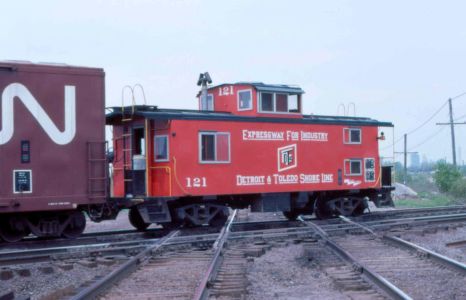- Details
- Hits: 3390
Railroad: Detroit and Toledo Shore Line Railroad Company, The
The Detroit & Toledo Shore Line railroad was a late arrival to the Detroit marketplace. It was a high traffic line built from north Toledo to the Delray area southwest of Detroit in 1903 by the Grand Trunk Western and the Clover Leaf (Toledo, St. Louis & Western).
The Grand Trunk wanted access to Toledo and points south, and the Clover Leaf wanted to tap the fast growing Detroit industrial market. The two roads each owned 50% of the D&TSL and rotated the Presidency of the DT&SL annually between the two owners. The line operated 43 miles from River Rouge to the Ohio state line, and 4.6 miles in Ohio. They had only 1.6 miles of sidings and spurs as of 1903. They also leased 3.1 miles of Wabash railroad to reach West Detroit, 11.2 miles of the Detroit Southern from Trenton to reach West End Avenue in Delray, 13.7 miles of the Toledo Terminal and 3.3 miles of the Clover Leaf from Copeland to Michigan Central Junction. [MCR-1904].
The line quickly became double-tracked allowing high capacity and speed when running trains between these two terminals. The road had terminal yards near Toledo (Lang Yard) and at Dearoad (in River Rouge, MI). Dispatching was performed from yard offices at Dearoad and the railroad had train order stations in Wyandotte, Trenton, Slocum Junction, Monroe, and Lang.
Built → Detroit & Toledo Shore Line Railroad → Grand Trunk Western → CN
Built: 1903 from River Rouge to Ohio state line by the GTW (50%) and the Clover Leaf (50%). The Clover Leaf merged into the Nickel Plate Road in 1922 which took over ownership of that share.
Operated for 78 years.
Became: Sole ownership by the Grand Trunk Western in 1981, then later merged into the Canadian National Ry.
Reference: [MRRC]

Notes
The railroad operated through trains south to Toledo originating at GTW locations in Durand, Port Huron, Pontiac and various yards in Detroit. Eventually, Dearoad was downgraded as a crew starting point and terminal operations were transferred to a location called Edison (south of Trenton). Trains north of Edison were crewed from their originating location on the GTW.
The D&TSL never ran scheduled passenger trains, though at least one depot was built at Monroe which was used for freight and as a block station. A number of passenger specials and excursions were operated over the years.
The Clover Leaf became part of the Nickel Plate Road in 1922 and later merged into the Norfolk & Western. In 1981, the GTW purchased the N&W 50% share of the road and later the GTW merged into the Canadian National railroad.
[MRRC], [MRL], [EFI] and other sources.
Photo Info: A D&TSL caboose #121 bringing up the end of a puller at Vickers Crossing on the Toledo Terminal in 1975. Pullers operated between Lang Yard and other railroad yards in the Toledo area using Toledo Terminal's belt line. [Charlie Whipp photo]
Time Line
1902. Railroad has been constructed "for some time" between Ohio state line and Trenton, but not operated. On September 8th, road was completed to River Rouge and opened for public service in the latter part of October. Constructed with 70-80 lb. rail. Crossing at Monroe with the Monroe Electric line protected by a half-interlocker. [MCR-1903]
1903. SHAPSHOT: The D&TSL employed 12 engineers, 10 firemen, 7 conductors and 16 brakemen, along with 155 laborers (mostly section hands) and 10 shopmen. At this time, the railroad only owned 2 locomotives, apparently utilizing owner locomotives (GTW and Clover Leaf) on through freights. Top five categories of tonnage hauled were: Bituminous coal (62%), merchandise (11%), lumber (5%), other mill products (4%) and hay (4%).
1920. The Detroit & Toledo Shore Line serves 4 industries in Detroit with 15 sidings and a car capacity of 210 cars. They have seven sets of team tracks which hold 280 cars and utilize freight houses of the Grand Trunk terminals. [DWT-1920]
1922. The D&TSL has use of Grand Trunk facilities at Detroit for which they pay GT $5,000 per month. The GT handles all D&TSL freight business in Detroit Terminals, switches all cars, does accounting, billing, etc. and charges the D&TSL $9.75 per loaded switch car (no charge for empties) plus $1 per car reclaim, less switching charges collected through Agent's accounts, per agreement dated November 1, 1921. LCL freight is handled at Avery Avenue and Trombly Avenue freight houses. Freight is handled by truck to the Beaubien Street freight house. [GT memorandum from 1935]
Books
The authoritative book on the D&TSL and its operations is the "Detroit & Toledo Shore Line, Expressway For Industry" by Charles H. Geletzke, Jr. and Wilbur E. Hague, ©2016, Kutztown Publishing Col, Inc.
Bibliography
The following sources are utilized in this website. [SOURCE-YEAR-MMDD-PG]:
- [AAB| = All Aboard!, by Willis Dunbar, Eerdmans Publishing, Grand Rapids ©1969.
- [AAN] = Alpena Argus newspaper.
- [AARQJ] = American Association of Railroads Quiz Jr. pamphlet. © 1956
- [AATHA] = Ann Arbor Railroad Technical and Historical Association newsletter "The Double A"
- [AB] = Information provided at Michigan History Conference from Andrew Bailey, Port Huron, MI

